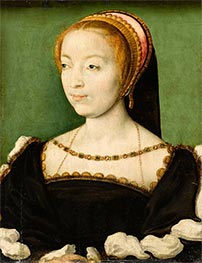
Corneille de Lyon Giclée Fine Art Prints
1500-1575
French Northern Renaissance Painter
Corneille de Lyon is a painter whose work, despite its small scale and quiet intimacy, captures the very essence of the French court in the 16th century. Born in The Hague around 1500, he later moved to Lyon, where he would spend most of his life, and it’s from this city that his legacy takes its name. There is little known about his early training, though it is likely that his style was shaped by Netherlandish traditions. But it is in Lyon, with its flourishing mercantile culture and connections to the royal court, that Corneille truly came into his own. By 1534, he was the official portraitist to Eleonore of Austria, and by the 1540s, he had become the favored painter of the future Henri II.
Corneille’s portraits are small, even intimate, but within their tight frames, they hold an extraordinary power. These bust-length depictions of court figures – their faces emerging against a stark green or blue background – are less about grandeur and more about presence. His work offers something deeply personal, a kind of quiet revelation of his sitters. They are not overt displays of wealth or status, but finely tuned observations. Each face seems to look directly at the viewer, the sitter’s gaze full of life and character, as though you’ve caught them in a fleeting moment of self-reflection.
By 1547, Corneille had risen to the very heights of the French court, becoming "peintre et premier valet de chambre" to Henri II. His portraits had by then become the favored means of capturing the likenesses of the French elite. Pierre de Bourdeille Brantôme recounts how, in 1564, both Catherine de’ Medici and Charles IX visited Corneille’s studio to view his portraits of the court’s grandest figures. It’s a revealing scene, suggesting that his small paintings – so full of restrained emotion – were seen as vital records of the most powerful members of French society.
Though around 200 works are attributed to him, Corneille’s work remains enigmatic. His style evolved gradually, with later works showing a more fluid brushstroke and lighter use of shadow, but the format remained constant: small, meticulous, and deeply personal. Unlike other court painters, such as the Clouets, Corneille’s paintings feel almost private. There is a sense of life captured in the space of a few inches, a portrait of an individual’s inner world, their thoughts frozen just beneath the surface. Corneille died in 1575, his work standing as a remarkable visual record of the French nobility, but more than that, as a testament to his unique ability to convey both power and vulnerability within the confines of a small frame. His portraits may be diminutive, but they are filled with the richness of human experience.
Corneille’s portraits are small, even intimate, but within their tight frames, they hold an extraordinary power. These bust-length depictions of court figures – their faces emerging against a stark green or blue background – are less about grandeur and more about presence. His work offers something deeply personal, a kind of quiet revelation of his sitters. They are not overt displays of wealth or status, but finely tuned observations. Each face seems to look directly at the viewer, the sitter’s gaze full of life and character, as though you’ve caught them in a fleeting moment of self-reflection.
By 1547, Corneille had risen to the very heights of the French court, becoming "peintre et premier valet de chambre" to Henri II. His portraits had by then become the favored means of capturing the likenesses of the French elite. Pierre de Bourdeille Brantôme recounts how, in 1564, both Catherine de’ Medici and Charles IX visited Corneille’s studio to view his portraits of the court’s grandest figures. It’s a revealing scene, suggesting that his small paintings – so full of restrained emotion – were seen as vital records of the most powerful members of French society.
Though around 200 works are attributed to him, Corneille’s work remains enigmatic. His style evolved gradually, with later works showing a more fluid brushstroke and lighter use of shadow, but the format remained constant: small, meticulous, and deeply personal. Unlike other court painters, such as the Clouets, Corneille’s paintings feel almost private. There is a sense of life captured in the space of a few inches, a portrait of an individual’s inner world, their thoughts frozen just beneath the surface. Corneille died in 1575, his work standing as a remarkable visual record of the French nobility, but more than that, as a testament to his unique ability to convey both power and vulnerability within the confines of a small frame. His portraits may be diminutive, but they are filled with the richness of human experience.
1 Corneille de Lyon Artworks

Giclée Canvas Print
$62.05
$62.05
SKU: 18001-LYC
Corneille de Lyon
Original Size:16 x 12 cm
Louvre Museum, Paris, France
Corneille de Lyon
Original Size:16 x 12 cm
Louvre Museum, Paris, France